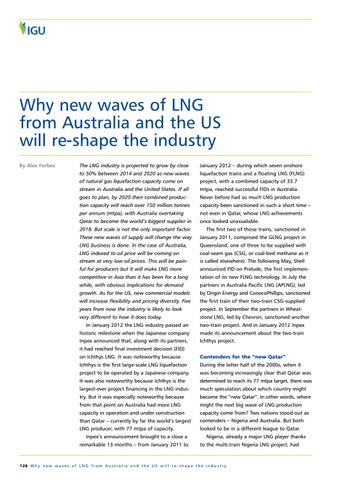Why new waves of LNG from Australia and the US will re-shape the industry By Alex Forbes
The LNG industry is projected to grow by close
January 2012 – during which seven onshore
to 50% between 2014 and 2020 as new waves
liquefaction trains and a floating LNG (FLNG)
of natural gas liquefaction capacity come on
project, with a combined capacity of 33.7
stream in Australia and the United States. If all
mtpa, reached successful FIDs in Australia.
goes to plan, by 2020 their combined produc
Never before had so much LNG production
tion capacity will reach over 150 million tonnes
capacity been sanctioned in such a short time –
per annum (mtpa), with Australia overtaking
not even in Qatar, whose LNG achievements
Qatar to become the world’s biggest supplier in
once looked unassailable.
2018. But scale is not the only important factor.
The first two of those trains, sanctioned in
These new waves of supply will change the way
January 2011, comprised the GLNG project in
LNG business is done. In the case of Australia,
Queensland, one of three to be supplied with
LNG indexed to oil price will be coming on
coal-seam gas (CSG, or coal-bed methane as it
stream at very low oil prices. This will be pain
is called elsewhere). The following May, Shell
ful for producers but it will make LNG more
announced FID on Prelude, the first implemen
competitive in Asia than it has been for a long
tation of its new FLNG technology. In July the
while, with obvious implications for demand
partners in Australia Pacific LNG (APLNG), led
growth. As for the US, new commercial models
by Origin Energy and ConocoPhillips, sanctioned
will increase flexibility and pricing diversity. Five
the first train of their two-train CSG-supplied
years from now the industry is likely to look
project. In September the partners in Wheat
very different to how it does today.
stone LNG, led by Chevron, sanctioned another
In January 2012 the LNG industry passed an
two-train project. And in January 2012 Inpex
historic milestone when the Japanese company
made its announcement about the two-train
Inpex announced that, along with its partners,
Ichthys project.
it had reached final investment decision (FID) on Ichthys LNG. It was noteworthy because
Contenders for the “new Qatar”
Ichthys is the first large-scale LNG liquefaction
During the latter half of the 2000s, when it
project to be operated by a Japanese company.
was becoming increasingly clear that Qatar was
It was also noteworthy because Ichthys is the
determined to reach its 77 mtpa target, there was
largest-ever project financing in the LNG indus
much speculation about which country might
try. But it was especially noteworthy because
become the “new Qatar”. In other words, where
from that point on Australia had more LNG
might the next big wave of LNG production
capacity in operation and under construction
capacity come from? Two nations stood out as
than Qatar – currently by far the world’s largest
contenders – Nigeria and Australia. But both
LNG producer, with 77 mtpa of capacity.
looked to be in a different league to Qatar.
Inpex’s announcement brought to a close a remarkable 13 months – from January 2011 to
Nigeria, already a major LNG player thanks to the multi-train Nigeria LNG project, had
126 W h y n e w w a v e s o f L N G f r o m A u s t r a l i a a n d t h e U S w i l l r e - s h a p e t h e i n d u s t r y
